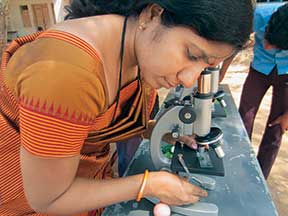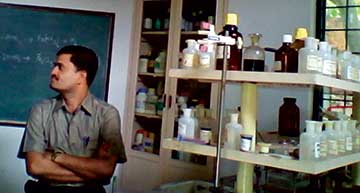Compiled by Parimal Agnihotri
There is a belief that science is difficult to study as well as to teach. The “central science” or “Bridge science” synonymous with chemistry is the reason behind this belief. Recently, science teachers at Yadgir district, Karnataka, came together to discuss their approaches to teaching chemistry. Most of the teachers had different perspectives and almost everyone found teaching the subject challenging. Here is a summary of the discussions:
Perspectives
About chemistry: School chemistry introduces the basic concepts. To understand these, prior knowledge of some of the physical science and mathematical concepts and rules is essential. Some of the areas are easy to learn; for example, “atomic structure”, and “acids and bases”. Some are difficult; for example, “chemical equations,”“energy and enthalpy” and “oxidation and reduction”. There are some interesting areas too such as biochemistry, organic chemistry, atomic structure, which extend the understanding of chemistry and its applications.
Relevance: The chemistry curriculum at school level is irrelevant and seldom applicable in everyday life. Why should one either teach or learn in such an abstract manner the manufacturing process of cement through diagrams or models or even through field visits? Why not Kitchen chemistry? The content in analytical chemistry should aid both learners and teachers to analyze soil, food, water, etc. Relevant context-based content alone will make chemistry education more meaningful.

Discussions
Biochemistry is interesting but difficult: Biochemistry has many connections to the human body and health and contains some interesting topics. However it is often considered to be a broad area with high level of detail, where much text needs to be read and only a few general rules need to be followed. It is therefore both a comprehensive and abstract subject. Another problem is the modelling and the shift between macro, sub-micro and representational/symbolic levels. Chemical phenomena are often presented in textbooks at the symbolic level, and they are explained at the, unobservable, sub-micro level. Students have problems linking and relating these macro-micro-levels. The same is evident if we inquire about a student’s capacity to see structure-property-relationships in organic and biochemistry, and studying subjects related to everyday life.
The working methods satisfy students: Chemistry lessons are often teacher-centered with a teacher talking or discussing topics with students. When students work on their own, they think they learn chemistry well. Laboratory work and demonstrations are regarded as fundamental methods of working. Laboratory work is an essential part of inquiry-based learning, and laboratory activities based on inquiry can give students opportunities to learn and develop concepts and frameworks of concepts. Students also show improved attitudes and interest in science when they are introduced to laboratory work. On the other hand, students often have problems understanding the purpose of their laboratory work and seldom use higher-level cognitive skills, since laboratory guides often follow a “cookbook” approach. All of us often wish to do more practical work, but lack of time and money is a deterrent.

Dichotomy of the curriculum – science for everyone or science for the future scientist: Our day starts with chemicals. We use a lot of chemicals everyday such as soaps, shampoos, toothpaste, deodorants, shaving creams and beauty products. Our kitchen itself is a vibrant chemical lab and each ingredient is a chemical and each process in the kitchen too. Over the counter drugs and homemade remedies for common ailments, paints, food colours, colours used while playing Holi, food adulteration materials are all chemicals. Idly or dosa batter is a chemical process. For that matter, anything we come across in this universe is a chemical by default. What we mean by ‘science for everyone’ is an attempt to answer the “what’’ in the question about chemical composition of these day-to-day consumption items, their usefulness and hazardous effects and their judicious usage. These should be covered in the content of school chemistry.

Challenges
- Having even the basic infrastructure in schools that are in remote rural areas is a big challenge.
- Student absenteeism poses the challenge of continuity.
- Missing links in the content makes classroom transaction difficult.
- To get rid of the fear of chemicals and processes in a laboratory is a challenge.
- Pooling of raw materials for science labs is difficult.
- To overcome our limited competencies in lab experiments.
- Too crowded classrooms.
- Pooling sufficient reference resources.
- Difficulty in preparing teaching and learning material for chemistry teaching.
- Lack of basic knowledge in children.
- To acquire minimum requisite knowledge in designing innovative activities to teach chemistry.
Conclusions
After a lot of debate, we were able to draw some conclusions. The role of secondary school science, especially chemistry, is often discussed from the point of view of whether it should be ‘science for everyone’ or ‘science for the future scientist’. It is essential for these to coexist since there is a need for both future scientists as well as a well-educated public. We think students, who are studying in secondary school are possible future scientists and we also think it is fundamental that chemistry at the school level be related to everyday life. We agree that chemistry is more than factual knowledge. Students need to discuss whatever they know about the subject with us so that we can ensure they can go beyond just the basic knowledge and develop an understanding of the subject.
The teachers who participated in the discussion are:
Gurubasavaraj, Govt. Boys High School, Shahapur; Zahara Begum, Adarshvidyalaya (English medium Govt. High School), Shahapur; Dinesh, Govt. High School, Moodbal village; Anil Angadaki, Azim Premji School, Yadgir; Akkamahadevi S Patil, Yadgir District Institute, Azim Premji Foundation, Yadgir.
The author is with the Yadgir District Institute, Azim Premji Foundation, Yadgir. He can be reached at parimalacharya.a@azimpremjifoundation.org.
